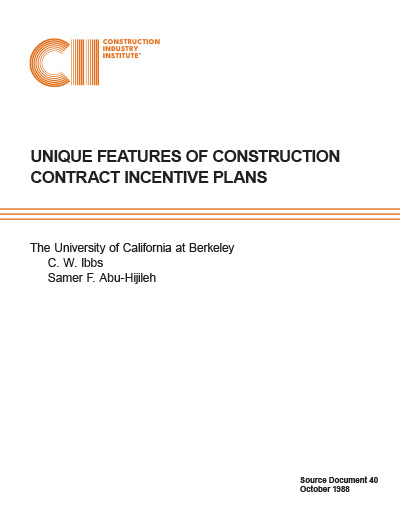
Impact of Risk Allocation and Equity in Construction Contracts
The Construction Industry Institute (CII) Contracts Task Force engaged in this research with the principal objective – “to improve project cost effectiveness and participant relationships through a study of risk allocation in certain contract clauses.” After further thought and examination, the Contracts Task Force narrowed the focus of the risk allocation study down to indemnity, consequential damage, differing conditions, and delay clauses utilized in lump sum contracts.
Hypotheses were developed concerning the impact of risk allocation and the equity of that allocation on project performance and working relationships among the participants. Responses from 35 CII member companies to a detailed questionnaire were compiled into two databases. In addition, 43 contracting personnel attended one of three group interviews used to expand discussion of issues raised in the research.
An examination into the legal background of each clause area provided insight into applications of these clauses and common law implications when they are not specifically addressed in the contract. Further analysis showed that project performance and owner-contractor working relations severely suffered from use of inequitable risk allocations in these clauses. Owner and contractor opinions were compared and contrasted to demonstrate commonality and robustness of the analyses. The following conclusions and recommendations were drawn from both the data analyses and review of group interview results.
Conclusions
- Careful and thoughtful selection of indemnity, consequential damage, differing conditions, and delay clauses that do not grossly and inequitably allocate all risk to the contractor, positively impacts overall project performance and the owner-contractor working relationship.
- Every risk has an associated price – visible or hidden. Visible costs appear in project bids as contingency or insurance costs and can be compared. Onerous contract conditions promote hidden costs. Hidden costs (in terms of time and money) derived from this study include: (a) the cost of restricted bid competition (b) the cost of increased claims/disputes (c) the cost of replacing a lesser quality contractor who is more likely to unknowingly accept a grossly inequitable risk allocation (d) the cost of harboring an adversarial owner-contractor relationship in terms of final product quality, expeditious change order processing, reputation, and ultimate project outcome.
- Properly written liquidated damage clauses typically deny the owner recovery of delay-related consequential damages and direct damages in excess of the specified amount. Liquidated damages are considered an advance owner assessment of those costs and not a penalty. Liquidated damages can be advantageous to an owner faced with possible consequential damage risk in that they allow retention of contractor payments rather than litigation for their recovery and to contractors in that they provide an advance, firm price determination of the risk involved. A prior CII-supported study, however, determined that liquidated damage clauses are often viewed by a contractor as a negative incentive and may diminish project performance. Thus, this clause must be used with caution.
- Areas of future research suggested by this study include: 1) the effect of contractor-subcontractor contractual arrangements on project cost effectiveness and working relations, and 2) development of mechanisms and processes to obtain owner and contractor objectives in claims management and analysis.
Recommendations by Clause Area
Indemnity
- Do not use onerous, broad form indemnity provisions that make the contractor responsible for contractor’s sole negligence as well as joint and owner’s sole negligence. They are not cost effective and they hinder quality, timely compliance, and the owner-contractor working relations.
- Use intermediate form indemnity provisions where each party accepts its own sole negligence with the contractor accepting all joint negligence with caution. Restrict use of this clause to projects where numerous disputes are possible because of the nature of the owner-contractor relationship. Selective use of this clause will offset any decreased cost effectiveness with fewer disputes about proportion of negligence.
- Use limited form indemnity provisions to clarify owner and contractor responsibilities. In the absence of any clause, common law will dictate this position, but use of this clause will make some contractors feel more at ease.
Consequential Damages
- Avoid the use of consequential damage clauses that shift all the risk onto the contractor. They adversely impact cost and quality in an effort to promote schedule. This clause also greatly inhibits owner-contractor working relations.
- Use a clause where risk of most consequential damages are retained by the owner when consequential damages are unbearable and grossly out of proportion with contractor profit, a favorable owner-contractor relationship exists and the contract provides sufficient incentive for contractor performance.
- Use a clause that has a limited risk, a cap on liability exposure, of consequential damages shifted to the contractor with most any project. While not necessarily the most equitable clause, this clause distributes risk according to market rules and common sense.
Differing Conditions
- Differing conditions risk can be assumed most effectively by the owner. The contractor must, however, bear the burden of identification and notification so there is sufficient motivation to perform.
- Use unit prices for items in lump sum contracts which cannot be effectively bid lump sum (e.g., subsurface conditions). Base unit prices on various quantity ranges.
- Owners should allow contractors to rely on owner furnished data but should also make contractors liable for interpretations of the data.
Delay
- Do not use “no damages for delay” clauses where there is significant probability of delay.
- Share delay risk where each party is responsible for its own delays and concurrent delays are shared to the extent each party is responsible.
- Establish an education process for all parties involved in the project. This instruction may include issues such as:
(a) Implications of risk allocations on project performance
(b) Difference between contract administration on cost reimbursable and lump sum contracts
(c) Definition of delays, costs of delays, and how costs are calculated
General Recommendations
The owner or its representative has an essential role in improving working relationships, contract execution, and overall project performance, by the decisions made regarding risk allocation. This research documents the general conclusion that use of onerous contract provisions that cause the contractor to assume inequitable, unbearable, and uncontrollable risks will directly and negatively impact the owner-contractor working relationship.
Beyond equitable allocation of risk there are additional steps an owner can take to improve working relationships. Several firms interviewed in this study suggested the development of project problem-solving teams with owner and contractor personnel to anticipate potential project problems and provide workable solutions in advance. Another contributed suggestion was to give increased authority to the owner’s on-site project manager so decisions can be made at levels closer to the work.
Improved contract execution can result from owner investment in preconstruction studies to better define risks. Execution can also be facilitated by development of a project execution manual consisting of detailed procedures for handling indemnity problems, consequential damages, differing conditions, and delays when they occur. Another suggestion was for more aggressive owner administration and documentation of project problems to prevent unnecessary claims and disputes.
Final Comments
Owners typically resist changing contract content for fear that such changes will adversely disrupt their means of purchasing construction services. The modifications that do occur often focus on allocating additional risks to the contractor. Recommendations included in this report may represent for many firms a dramatic shift from present methods of allocating contractual risk. The research evidence supporting these recommendations, however, is substantial. Both owners and contractors are thus encouraged to use the information contained within this document to stimulate development of contract terms that more positively support project performance and participant working relationships.



